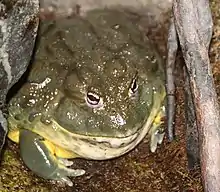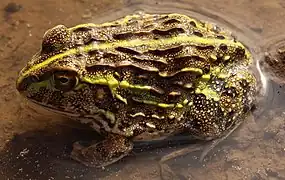African bullfrog
The African bullfrog (Pyxicephalus adspersus), also known as the Giant bullfrog or the South African burrowing frog, is a species of frog in the family Pyxicephalidae. It is also known as the pixie frog due to its scientific name. It is found in Angola, Botswana, Kenya, Malawi, Mozambique, Namibia, South Africa, Tanzania, Uganda, Zambia, Zimbabwe, and possibly the Democratic Republic of the Congo. It has been extirpated from Eswatini.[1] It has long been confused with the edible bullfrog (P. edulis), and species boundaries between them, including exact range limits, are not fully understood.[1][2] Additionally, P. angusticeps of coastal East Africa only was revalidated as a separate species in 2013.[2]
| African bullfrog | |
|---|---|
 | |
 | |
| Scientific classification | |
| Domain: | Eukaryota |
| Kingdom: | Animalia |
| Phylum: | Chordata |
| Class: | Amphibia |
| Order: | Anura |
| Family: | Pyxicephalidae |
| Genus: | Pyxicephalus |
| Species: | P. adspersus |
| Binomial name | |
| Pyxicephalus adspersus Tschudi, 1838 | |
| African bullfrog distribution
Extant (resident) | |
The natural habitat of the African bullfrog is moist to dry savanna, subtropical to tropical dry shrubland, intermittent freshwater lakes, intermittent freshwater marshes, arable land, pastureland, canals, and flooded ditches. It is among the largest anurans on the planet, sixth only to the goliath frog, the helmeted water toad, the Lake Junin frog, the Blyth's river frog, and the cane toad.[3]
Appearance
The males weigh up to 1.4 kg (3.1 lb) and grow to 24.5 cm (9.6 in) in snout–to–vent length. Females are half the size of males, which is unusual, considering that most female amphibians are (generally) larger than males, to help the amplexus.[4][5][6] The dorsum is dark olive-green in adults. Juveniles have bright green coloration with a yellow stripe down the back.[7] The abdomen is white to creamy-yellow with breeding males having yellow forelimbs.[8]
Feeding and habits
The African bullfrog is a voracious carnivore, eating insects, other invertebrates, small rodents, reptiles, small birds, fish, and other amphibians that can fit in their mouths.[5][9][10] It is also a cannibalistic species—the male African bullfrog is known for occasionally eating the tadpoles he guards,[11] and juveniles also eat tadpoles.[12] An African bullfrog kept at the Pretoria Zoo in South Africa once ate 17 juvenile Rinkhals snakes (Hemachatus haemachatus).[13]
When exposed to dry conditions, they become dormant and may form a cocoon which covers the entire body surface except the external nostrils. The cocoon significantly decreases the rate of evaporative water loss.[14] When it rains, the water softens the cocoon and the frog crawls out.[7]
Reproduction
Breeding typically starts after about 65 mm (2.6 in) of rain over the course of two days. They breed in shallow, temporary water bodies, such as pools, pans, and ditches. Eggs are laid in the shallow edge of the pond, but fertilization takes place above water.[15]
The African bullfrog males call out during the rainy season. The call lasts about a second and can be described as a low-pitched whoop.[16] Males have two breeding strategies, depending on their age. Young males congregate in a small area, perhaps only 1–2 m2 (11–22 sq ft) of shallow water. The larger males occupy the centre of these breeding arenas or leks, and attempt to chase off other males. Often, they fight, causing injury or even killing one another. The dominant male attempts to prevent other males from breeding. A female approaches the group of males by swimming along at the surface until she is within a few metres of the group. Then, the female dives to avoid the smaller males and surfaces in the defended area of a larger male in the middle of the group. This helps to ensure that she mates with the dominant male.[15][17]
The female lays about 3,000 to 4,000 eggs at a time. The tadpoles hatch, and after two days, start feeding on vegetation, small fish, invertebrates, and even each other. Defending males continue to watch over the tadpoles, which metamorphose within three weeks. During the tadpole's development, the father guards his young. Due to the male bullfrog's overprotective behaviour, he pounces and bites anything that he views as a threat. If the pool is in danger of drying out, the father uses his legs and head to dig a canal from the drying pond to a bigger pond. He continues to guard the tadpoles until they are old enough to fend for themselves, although he may also eat some of them.[15][18]
Status
They are listed as "least concern" globally. However, they are considered "near threatened" in South Africa due to habitat loss.[19]
Human use
The African bullfrog is an exotic pet in many countries around the world. Animals sold are generally bred in captivity. Pet African bullfrogs may live for 35 years in captivity.[5] As pets, African bullfrogs are considered to be easygoing and low-maintenance in terms of their care. Pet African bullfrogs should be housed in a tank at least 10 gallons large, and should receive roughly 12 hours of light and 12 hours of darkness daily. The enclosure should be kept at a temperature of or around 75 degrees Fahrenheit, and the humidity level should be maintained at around 80 to 90 percent. African bullfrog pet owners should be aware that these animals typically do not like to be held and handled by humans, and that they tend to bite their handlers when handled in a way that causes the animal stress.[20]
It is considered a delicacy in Namibia.[21]
Gallery
References
- IUCN SSC Amphibian Specialist Group (2013). "Pyxicephalus adspersus". IUCN Red List of Threatened Species. 2013: e.T58535A3070700. doi:10.2305/IUCN.UK.2013-2.RLTS.T58535A3070700.en. Retrieved 15 November 2021.
- Scott, E.; J.D. Visser; C.A. Yetman; L. Oliver; D.G. Broadley (2013). "Revalidation of Pyxicephalus angusticeps Parry, 1982 (Anura: Natatanura: Pyxicephalidae), a bullfrog endemic to the lowlands of eastern Africa". Zootaxa. 3599 (3): 201–228. doi:10.11646/zootaxa.3599.3.1. hdl:2263/57608. PMID 24613871.
- "Giant African Bullfrog".
- Evans S, Groenke J, Jones M, Turner A, Krause D (2014). "New Material of Beelzebufo, a Hyperossified Frog (Amphibia: Anura) from the Late Cretaceous of Madagascar". PLOS ONE. 9 (1): e87236. Bibcode:2014PLoSO...987236E. doi:10.1371/journal.pone.0087236. PMC 3905036. PMID 24489877.
{{cite journal}}: CS1 maint: multiple names: authors list (link) - Gampper, Terry (2002). "The Natural History and Care of the African Bullfrog". Melissa Kaplan's Herp Care Collection. Retrieved 2018-11-11.
- Loveridge, Arthur (1950). "History and habits of the East African bullfrog" (PDF). J. East Afr. Nat. Hist. Soc. 19: 253–275. Retrieved 9 November 2018.
- "African bullfrog". Britannica Kids.
- Bishop, P. (19 October 2004). "Pyxicephalus adspersus". AmphibiaWeb. Retrieved 11 January 2020.
- "Pyxicephalus adspersus". Animal Diversity Web.
- "African Bullfrog".
- "Bronberg: African bullfrog haven". 26 February 2009. Archived from the original on 21 April 2014. Retrieved 4 May 2014.
- Okeyo, Daniel; Kashea, Martha; Kandjengo, Lineekela (2014). "The Feeding habits of the Giant African Bullfrog (Anura: Pyxicephalidae: Pyxicephalus Adspersus Tschudi, 1839) of the Cuvelai Drainage System in Northern Namibia". Int. Sci. Technol. J. Namibia. 4: 62–71.
- Branch, W. R. (1976). "Two exceptional food records for the African bullfrog, Pyxicephalus adspersus (Amphibia, Anura, Pyxicephalidae)". Journal of Herpetology. 10 (3): 266–268. doi:10.2307/1562997. JSTOR 1562997.
- Loveridge, J.; Withers, P. (1981). "Metabolism and Water Balance of Active and Cocooned African Bullfrogs Pyxicephalus adspersus". Physical Zoology. 54 (2): 203–214.
- "African Bullfrog - Pyxicephalus adspersus". World Association of Zoos and Aquariums. Archived from the original on 2018-05-03. Retrieved 2018-11-11.
- "African Bullfrog - Pyxicephalus adspersus - Details". Encyclopedia of Life. Retrieved 20 January 2015.
- Balinsky, J. B. (1954). "On the breeding habits of the South African bullfrog Pyxicephalus adspersus". South African Journal of Science. 51 (2): 55–58.
- Cook, C.L.; Ferguson, Jan W.H.; Telford, S.R. (June 2001). "Adaptive male parental care in the giant bullfrog, Pyxicephalus adspersus". Journal of Herpetology. 35 (2): 310. doi:10.2307/1566122. JSTOR 1566122.
- Yetman, Caroline; Ferguson, J. (2011). "Conservation Implications of Spatial Habitat Use by Adult Giant Bullfrogs (Pyxicephalus adspersus)". Journal of Herpetology. 45 (1): 56–62.
- "A Guide to Caring for African Bullfrogs as Pets". The Spruce Pets. Retrieved 2023-09-27.
- Okeyo, Daniel; Kandjengo, Lineekela; Kashea, Martha (2015). "Harvesting and consumption of the giant African bullfrog, a delicacy in northern Namibia". Indigenous Knowledge of Namibia. University of Namibia Press. pp. 205–218. doi:10.2307/j.ctvgc619h.15.

